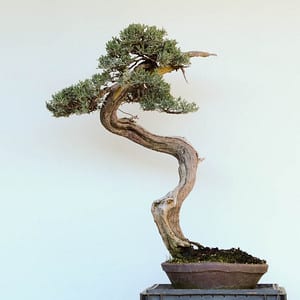I really like working with Japanese Black Pine. Although they keep needles year round, their appearance changes with the seasons. The pine below is flush with last year’s growth – a mix of spring and summer foliage. Spring growth above – Summer growth below As you might imagine, the future silhouette of this tree will […]
Bonsai Blog
Search
(Enter search terms and press 'Enter')
Recent Posts
Repotting and grafting ume
Almost 15 years ago, I signed up for my first Kathy Shaner workshop. I’d been informally studying with Kathy for some time – this would be my first opportunity to work with her on one of my own trees. Or soon to be mine. The trees for the event were included with workshop registration – […]
Repotting a Western juniper
While preparing a Western juniper for exhibit, I became curious as to why the tree was planted so far to one side of the pot. I was somewhat concerned because I couldn’t show the tree as it appeared below. Western juniper My worry was that all of the roots came from a single spot at […]
Moss technique
It’s common, when displaying bonsai at indoor exhibits, to cover the surface of the soil with moss. The alternative – dirt – doesn’t really compare. Scott decorated his Ponderosa Pine with a great arrangement of mosses and lichens at this year’s BIB exhibit. Moss on ponderosa pine Depending on where you live, you may have […]
Bonsai groves
People love groves. While individual bonsai trees can tend toward the abstract, groves remain accessible. When leading friends through bonsai exhibits, I make sure to stop by any groves as they are sure to leave an impression. This year a couple of groves stood out at BIB’s 11th annual exhibit. One, a rock-planting with Kingsville […]




